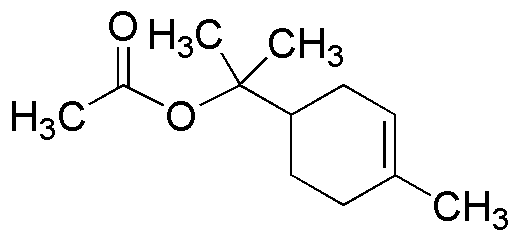Terpinyl acetate is widely utilized in research focused on:
- Fragrance Industry: This compound is a key ingredient in perfumes and cosmetics, providing a fresh, citrus-like aroma that enhances product appeal.
- Flavoring Agents: It is used as a flavoring agent in food and beverages, imparting a pleasant taste that can improve consumer satisfaction.
- Aromatherapy: Terpinyl acetate is popular in essential oils and aromatherapy products, known for its calming properties that can help reduce stress and promote relaxation.
- Pharmaceuticals: The compound has applications in the development of certain medications, where it can act as a solvent or carrier for active ingredients, improving their efficacy.
- Insect Repellents: Due to its natural origin and pleasant scent, it is often included in formulations for insect repellents, providing a safer alternative to synthetic chemicals.
General Information
Properties
Safety and Regulations
Applications
Terpinyl acetate is widely utilized in research focused on:
- Fragrance Industry: This compound is a key ingredient in perfumes and cosmetics, providing a fresh, citrus-like aroma that enhances product appeal.
- Flavoring Agents: It is used as a flavoring agent in food and beverages, imparting a pleasant taste that can improve consumer satisfaction.
- Aromatherapy: Terpinyl acetate is popular in essential oils and aromatherapy products, known for its calming properties that can help reduce stress and promote relaxation.
- Pharmaceuticals: The compound has applications in the development of certain medications, where it can act as a solvent or carrier for active ingredients, improving their efficacy.
- Insect Repellents: Due to its natural origin and pleasant scent, it is often included in formulations for insect repellents, providing a safer alternative to synthetic chemicals.
Documents
Safety Data Sheets (SDS)
The SDS provides comprehensive safety information on handling, storage, and disposal of the product.
Product Specification (PS)
The PS provides a comprehensive breakdown of the product’s properties, including chemical composition, physical state, purity, and storage requirements. It also details acceptable quality ranges and the product's intended applications.
Certificates of Analysis (COA)
Search for Certificates of Analysis (COA) by entering the products Lot Number. Lot and Batch Numbers can be found on a product’s label following the words ‘Lot’ or ‘Batch’.
*Catalog Number
*Lot Number
Certificates Of Origin (COO)
This COO confirms the country where the product was manufactured, and also details the materials and components used in it and whether it is derived from natural, synthetic, or other specific sources. This certificate may be required for customs, trade, and regulatory compliance.
*Catalog Number
*Lot Number
Safety Data Sheets (SDS)
The SDS provides comprehensive safety information on handling, storage, and disposal of the product.
DownloadProduct Specification (PS)
The PS provides a comprehensive breakdown of the product’s properties, including chemical composition, physical state, purity, and storage requirements. It also details acceptable quality ranges and the product's intended applications.
DownloadCertificates of Analysis (COA)
Search for Certificates of Analysis (COA) by entering the products Lot Number. Lot and Batch Numbers can be found on a product’s label following the words ‘Lot’ or ‘Batch’.
*Catalog Number
*Lot Number
Certificates Of Origin (COO)
This COO confirms the country where the product was manufactured, and also details the materials and components used in it and whether it is derived from natural, synthetic, or other specific sources. This certificate may be required for customs, trade, and regulatory compliance.


